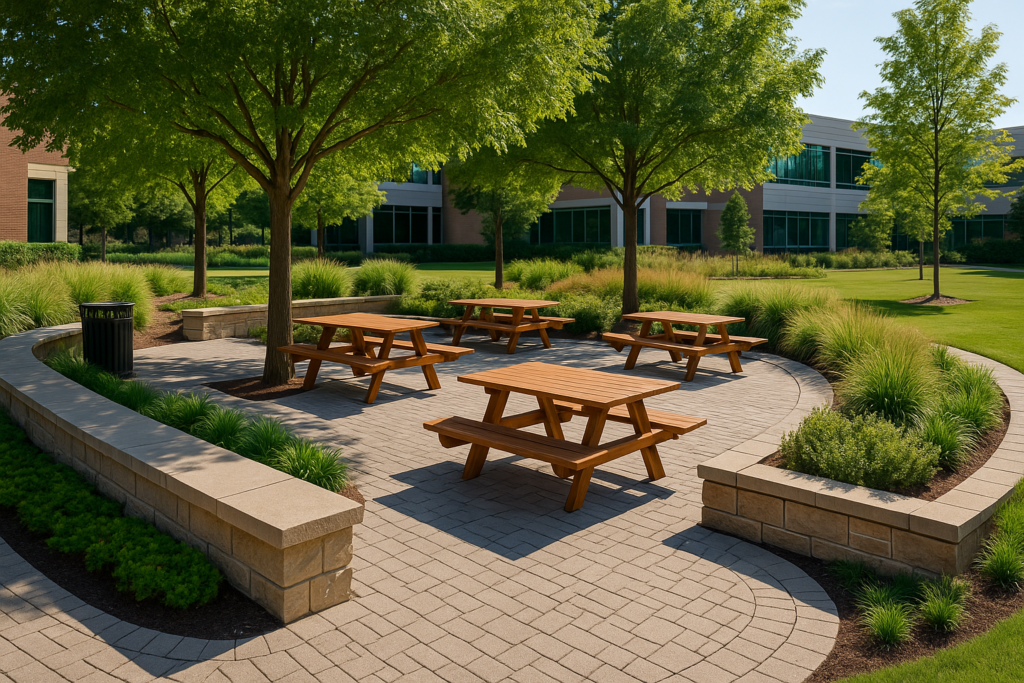A beautiful landscape is more than a visual delight—it’s a thoughtfully designed experience that invites people to relax, connect, and enjoy nature. By strategically combining seating and shade zones, landscape architects create outdoor spaces that are functional, sustainable, and engaging. These elements are especially important in public parks, corporate campuses, educational institutions, and healthcare settings where comfort and accessibility influence user satisfaction.
This comprehensive guide explores how to craft landscapes that integrate seating and shade into one harmonious design. Whether for leisure, work, or community engagement, the right balance of greenery, shelter, and usability fosters well-being and elevates property value.
The Importance of Seating and Shade in Landscape Design
Comfort Enhances Usability
Outdoor areas must provide respite from the sun, wind, or rain to encourage year-round use. Shaded seating allows people to linger longer, whether to rest, socialize, eat, or work.
Encouraging Community and Interaction
Benches, tables, and quiet nooks become social magnets when they offer physical comfort and environmental protection, turning green spaces into hubs of activity.
Boosting Mental and Physical Health
Comfortable, shaded outdoor spaces reduce heat exposure, improve mood, and encourage more frequent engagement with the outdoors.
Learn how these benefits tie into broader strategies in Beautiful Landscape Balancing Greenery and Usability.
Best Practices in Combining Seating and Shade Zones
Analyze Microclimate and Sun Paths
Understanding site-specific conditions like sun exposure, wind direction, and elevation allows for optimized shade placement that doesn’t obstruct views or airflow.
Use a Landscape Drawing to Plan Zones
A professional landscape drawing identifies the best spots for seating, accounting for natural shade from trees and man-made structures like pergolas, canopies, and green roofs.
Diversify Seating Options
Incorporate:
- Traditional benches with back support
- Modular seating for small groups
- Low retaining walls that double as seats
- Moveable chairs and picnic tables
This variety supports a range of users and activities.
Incorporate Both Natural and Structural Shade
Blend architectural and botanical elements for a layered approach to shelter:
- Tree canopies (e.g., maples, oaks, and elms)
- Pergolas with vines
- Tensioned fabric shade sails
- Trellises and vertical gardens
Integrating Landscape Architecture Principles
Design Cohesion
Shade structures and seating must align with the site’s materials, color palette, and spatial hierarchy to ensure aesthetic harmony.
Zoning for Activity
Use low hedges, paths, or grade changes to define spaces for:
- Quiet reflection
- Group conversation
- Outdoor dining or laptop work
These distinctions prevent crowding and increase usability.
Sustainable Material Use
Use FSC-certified wood, recycled plastic, and permeable paving around seating areas. These choices reduce environmental impact and maintenance costs.
See more in Beautiful Landscape Tailored for High-Traffic Areas.
Adding Seasonal and Sensory Value
Seasonal Plantings
Deciduous trees provide shade in summer and sunlight in winter. Pair with perennials and groundcovers for year-round beauty.
Fragrance and Soundscaping
Incorporate fragrant plants (like lavender or jasmine) and rustling leaves or water features to create relaxing sensory environments.
Pollinator and Wildlife Zones
Native shrubs and flowerbeds around seating attract butterflies, bees, and birds, enriching the experience and boosting biodiversity.
Safety, Accessibility, and Durability
ADA Compliance
Ensure all seating areas are wheelchair accessible, with smooth, slip-resistant paths and space for mobility devices.
Lighting for Safety
Install low-voltage, solar, or motion-sensor lighting for nighttime visibility and security.
Durable Construction
Use weather-resistant materials (e.g., powder-coated metals, stone, or concrete) to reduce wear and vandalism.
Examples of Effective Seating and Shade Combinations
Educational Campuses
Shaded plazas with integrated bench planters create informal study areas and event venues.
Corporate Grounds
Quiet seating courtyards offer lunchtime retreats or casual outdoor meetings.
Urban Parks
Flexible seating clusters beneath tree canopies or pergolas support family picnics and social gatherings.
Healthcare Facilities
Restful gardens with covered benches provide solace and stress relief for patients, visitors, and staff.
Explore these adaptable designs further in Beautiful Landscape Supporting Outdoor Work & Leisure.
Role of the Landscape Contractor
Site-Specific Installation
A professional landscape contractor ensures precise placement of structural shade features and site-appropriate seating solutions.
Coordination with Utilities and Infrastructure
Contractors manage site conditions, irrigation systems, and underground utilities while maintaining landscape integrity.
Long-Term Maintenance Plans
They provide care schedules for seating surfaces, plantings, and shade structures to ensure long-term function and appeal.
Final Thoughts
A beautiful landscape with thoughtfully combined seating and shade zones enriches outdoor experiences across all settings. By merging comfort, sustainability, and aesthetic appeal, landscape professionals create inclusive, durable, and memorable spaces.
With guidance from skilled landscape designers and landscape contractors, these elements work in harmony to meet both everyday needs and long-term environmental goals. Whether enhancing a public plaza or private campus, integrating seating and shade elevates landscapes from passive environments to dynamic destinations.
Investing in this approach ensures green spaces remain vital, inviting, and functional for years to come.

